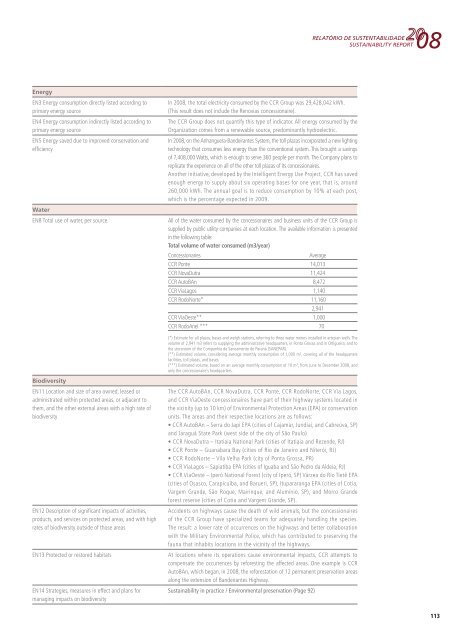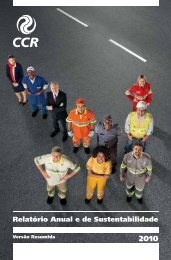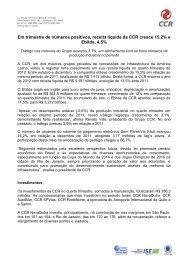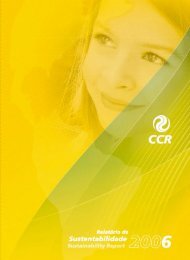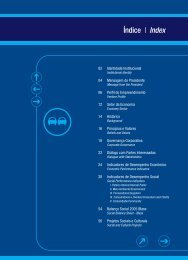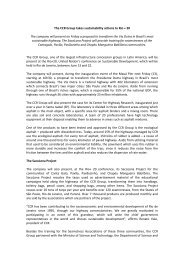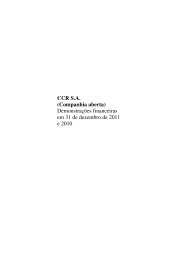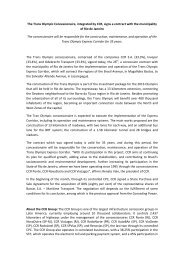pdf- Tamanho - Grupo CCR
pdf- Tamanho - Grupo CCR
pdf- Tamanho - Grupo CCR
Create successful ePaper yourself
Turn your PDF publications into a flip-book with our unique Google optimized e-Paper software.
Energy<br />
EN3 Energy consumption directly listed according to<br />
primary energy source<br />
EN4 Energy consumption indirectly listed according to<br />
primary energy source<br />
EN5 Energy saved due to improved conservation and<br />
efficiency<br />
Water<br />
EN8 Total use of water, per source.<br />
In 2008, the total electricity consumed by the <strong>CCR</strong> Group was 29,428,042 kWh.<br />
(This result does not include the Renovias concessionaire).<br />
The <strong>CCR</strong> Group does not quantify this type of indicator. All energy consumed by the<br />
Organization comes from a renewable source, predominantly hydroelectric.<br />
In 2008, on the Anhanguera-Bandeirantes System, the toll plazas incorporated a new lighting<br />
technology that consumes less energy than the conventional system. This brought a savings<br />
of 7,408,000 Watts, which is enough to serve 360 people per month. The Company plans to<br />
replicate the experience on all of the other toll plazas of its concessionaires.<br />
Another initiative, developed by the Intelligent Energy Use Project, <strong>CCR</strong> has saved<br />
enough energy to supply about six operating bases for one year, that is, around<br />
260,000 kWh. The annual goal is to reduce consumption by 10% at each post,<br />
which is the percentage expected in 2009.<br />
All of the water consumed by the concessionaires and business units of the <strong>CCR</strong> Group is<br />
supplied by public utility companies at each location. The available information is presented<br />
in the following table:<br />
Total volume of water consumed (m3/year)<br />
Concessionaries<br />
Average<br />
<strong>CCR</strong> Ponte 14,013<br />
<strong>CCR</strong> NovaDutra 11,424<br />
<strong>CCR</strong> AutoBAn 8,472<br />
<strong>CCR</strong> ViaLagos 1,140<br />
<strong>CCR</strong> RodoNorte* 11,160<br />
2,941<br />
<strong>CCR</strong> ViaOeste** 1,000<br />
<strong>CCR</strong> RodoAnel *** 70<br />
(*) Estimate for all plazas, bases and weigh stations, referring to three water meters installed in artesian wells. The<br />
volume of 2,941 m3 refers to supplying the administrative headquarters, in Ponta Grossa and in Ortigueira, and to<br />
the storeroom of the Companhia de Saneamento do Paraná (SANEPAR).<br />
(**) Estimated volume, considering average monthly consumption of 1,000 m³, covering all of the headquarters<br />
facilities, toll plazas, and bases.<br />
(***) Estimated volume, based on an average monthly consumption of 10 m³, from June to December 2008, and<br />
only the concessionaire’s headquarters.<br />
Biodiversity<br />
EN11 Location and size of area owned, leased or<br />
administrated within protected areas, or adjacent to<br />
them, and the other external areas with a high rate of<br />
biodiversity<br />
EN12 Description of significant impacts of activities,<br />
products, and services on protected areas, and with high<br />
rates of biodiversity outside of those areas<br />
EN13 Protected or restored habitats<br />
EN14 Strategies, measures in effect and plans for<br />
managing impacts on biodiversity<br />
The <strong>CCR</strong> AutoBAn, <strong>CCR</strong> NovaDutra, <strong>CCR</strong> Ponte, <strong>CCR</strong> RodoNorte, <strong>CCR</strong> Via Lagos,<br />
and <strong>CCR</strong> ViaOeste concessionaires have part of their highway systems located in<br />
the vicinity (up to 10 km) of Environmental Protection Areas (EPA) or conservation<br />
units. The areas and their respective locations are as follows:<br />
• <strong>CCR</strong> AutoBAn – Serra do Japi EPA (cities of Cajamar, Jundiaí, and Cabreúva, SP)<br />
and Jaraguá State Park (west side of the city of São Paulo)<br />
• <strong>CCR</strong> NovaDutra – Itatiaia National Park (cities of Itatiaia and Rezende, RJ)<br />
• <strong>CCR</strong> Ponte – Guanabara Bay (cities of Rio de Janeiro and Niterói, RJ)<br />
• <strong>CCR</strong> RodoNorte – Vila Velha Park (city of Ponta Grossa, PR)<br />
• <strong>CCR</strong> ViaLagos – Sapiatiba EPA (cities of Iguaba and São Pedro da Aldeia, RJ)<br />
• <strong>CCR</strong> ViaOeste – Iperó National Forest (city of Iperó, SP) Várzea do Rio Tietê EPA<br />
(cities of Osasco, Carapicuíba, and Barueri, SP), Itupararanga EPA (cities of Cotia,<br />
Vargem Grande, São Roque, Mairinque, and Alumínio, SP), and Morro Grande<br />
forest reserve (cities of Cotia and Vargem Grande, SP).<br />
Accidents on highways cause the death of wild animals, but the concessionaires<br />
of the <strong>CCR</strong> Group have specialized teams for adequately handling the species.<br />
The result: a lower rate of occurrences on the highways and better collaboration<br />
with the Military Environmental Police, which has contributed to preserving the<br />
fauna that inhabits locations in the vicinity of the highways.<br />
At locations where its operations cause environmental impacts, <strong>CCR</strong> attempts to<br />
compensate the occurrences by reforesting the affected areas. One example is <strong>CCR</strong><br />
AutoBAn, which began, in 2008, the reforestation of 12 permanent preservation areas<br />
along the extension of Bandeirantes Highway.<br />
Sustainability in practice / Environmental preservation (Page 92)<br />
113


